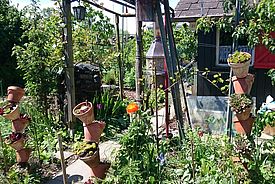19.03.2019 | Reinhard Lässig | News WSL
Green spaces such as community or private gardens are a refuge for many people in urban areas. Gardens offer closeness to nature, tranquility and relaxation. They are a haven of biodiversity and have great social significance, as indicated by a survey conducted by the Swiss Federal Research Institute WSL and the Research Institute of Organic Agriculture (FiBL).
Densely built urban areas are often poor in plant and animal species and are avoided by people in their leisure time. In contrast, the open, unsealed areas as well as parks and gardens attract people. Researchers at the Federal Research Institute WSL and the Research Institute of Organic Agriculture (FiBL) wanted to find out why this is so. They submitted 48 interviews and two written surveys to around 1800 users of (individually cultivated) community gardens and home gardens, asking about the species diversity and social value of these gardens. The researchers also asked what drives these people to maintain a garden in a particular way.
City folks seeking distance from everyday life
The 724 analysable questionnaires of the first study showed that a large majority of garden owners and tenants primarily wants to get away from everyday life. That they succeed is shown by the second survey: "The majority of gardeners feel much more relaxed after a stay in the garden than before, and this effect is particularly noticeable in community gardens," says Nicole Bauer from WSL, summarising one of the central results. People living in cities visit their gardens primarily for fresh air, to enjoy the beauty of nature as well as find peace and quiet. For 15% of gardeners, however, gardening is also a stress factor because gardening sometimes means hard work.
The majority of tenants and owners are clearly committed to promote biological diversity. On the one hand because they find nature beautiful, on the other hand out of a sense of ecological responsibility. The gardeners promote biodiversity by creating vegetable and flower beds and habitats such as branch heaps for hedgehogs, nesting boxes for birds or meadow areas for insects and bee hotels. Dry stone walls to harbor insects and reptiles are particularly popular in private gardens.
The survey also shows that extensively managed gardens with many different structures and habitats are generally richer in animal and plant species and individuals than gardens with more homogeneous structures such as lawns. In terms of species diversity, family gardens are in the lead compared to domestic gardens. Example: Large-scale, but finely subdivided vegetable cultivation, as practised in community gardens, promotes pioneer species such as certain ground beetles. On the other hand, house gardens with a diverse tree vegetation attracts birds - especially in densely developed inner cities.
Gardens are both a social venue and an antithesis to densification
In addition to their recreational value, city gardens are places of social interaction, used not only by their tenants or owners, but also by neighbours and friends. Most gardeners receive up to ten guests over three months’ time. Robert Home of FiBL is convinced that "in the longer term, gardens will form an antithesis to densely populated neighbourhoods". "On the one hand for social reasons, because people in densely populated cities long for more peace and social contact, and on the other hand for ecological reasons, because the diversity of species and habitats in garden-rich neighbourhoods is greater than between tall houses and noisy streets."
The results of this study, financed by the Swiss National Science Foundation as part of the Sinergia programme, suggest that it would be wise to include privately cultivated areas in the cities' biodiversity strategies and concepts. These could thus benefit from the commitment of leisure gardeners. Particularly community gardens on the outskirts of the city make an important contribution to maintaining extensively cultivated green areas. If all this were taken into account in urban and spatial development, which usually leans towards densification, the quality of life in conurbations could be kept as high as possible.
Eight new insect species discovered
David Frey, Marco Moretti (WSL) and their colleagues investigated the biodiversity of plants and animals. They identified more than 150,000 invertebrates and detected a good 1100 animal and more than 1000 plant species. "Our data set on above-ground biodiversity is one of the largest in the world to be collected in gardens," says Frey. The average garden in the city of Zurich contains 119 plant species and 142 animal species. The researchers even found 8 insect species that have never before been recorded in Switzerland.
Contact ¶
Links and documents ¶
Copyright ¶
WSL und SLF stellen Bildmaterial zur Bebilderung von Presseartikeln im Zusammenhang mit dieser Medienmitteilung kostenfrei zur Verfügung. Eine Übernahme der Bilder in Bilddatenbanken und ein Verkauf der Bilder durch Dritte sind nicht gestattet.





